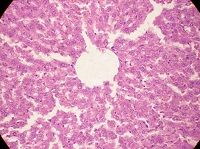Hepatoprotective Activity of Chenopodium Album Linn. Against Alcohol Induced Liver Damage
Keywords:
Chenopodium album Linn, hepatoprotective activity, alcohol; chronic hepatitis model, serum biochemical assessment, histopathologyAbstract
Dried aerial parts of Chenopodium album Linn. (Chenopodiaceae) are used in variety of diseases in traditional Indian system of medicine including hepatic ailments. The aim of present study was to validate hepatoprotective activity of aerial parts of Chenopodium album Linn using alcohol as chronic hepatitis model. Alcoholic [ALCA] and aqueous [ AQCA] extracts of the aerial parts of Chenopodium album at the doses of 200 and 400 mg/Kg were evaluated for hepatoprotective activity against alcohol induced hepatotoxicity using biochemical markers and by histopathological method. The aqueous extract at a dose of 400 mg/kg was found to be more potent when compared to Silymarin. ALCA and AQCA [200 & 400 mg/Kg] showed significant hepatoprotective activity against alcohol induced hepatotoxicity as evident by restoration of serum transaminases, alkaline phosphatase and bilirubin content. Histopathology of the liver tissue further confirmed the reversal of damage induced by hepatotoxin.Present study showed that the alcoholic and aqueous extracts of Chenopodium album significantly restore physiological integrity of hepatocytes. Aqueous and alcoholic extract did not show any sign of toxicity up to oral dose of 5 g/Kg in mice.
References
Petri WA. Antimicrobial agents. In : Gilman
AG, Hardman JG, Limbird LE, Editor. The
Pharmacological Basis of Therapeutics. Tenth
ed. New York: McGraw-Hill publication
Corporation; 2001;p.1189-1193.
Nadeem M, Dandia PC, Pasha KV, Imran M,
Balani DK, Vohora SB. Hepatoprotective
activity of Solanum nigrum fruits.
Fitoterap.1997;LXVIII: 245-251.
Nedialkova ZK, Nedialkov PT, Nikolov SD.
The genus Chenopodium: Phytochemistry,
Ethno pharmacology and Pharmacology.
Phcog Rev.2009;3(6):280-306.
Anonymous. The Wealth of India (Raw
Materials), Vol. 3, New Delhi: Publication and
Information Directorate, CSIR; 2001;p464-469.
Warrier PK. Indian Medicinal Plants- A
Compendium of 500 Species, Vol. 2, Chennai:
Orient Longman Pvt Ltd; 2001;p.61-62.
Agarwal SS, Yamrekar BP, Paridhavi M.
Clinical Useful Herbal Drug, New Delhi: Ahuja
Publishing House; 2005;p.10-12.
Panda H. Handbook on Medicinal Herbs with
Uses. New Delhi: Asia Pacific Business Press;
;p.325-26.
Pramila K, Neetu S, Anju R. Medicinal plants
used in traditional health care system
prevalent in Western Himalaya. Indian J
Traditional Knowled. 2006;5(3):300-309.
Khare CP. Indian Medicinal Plants, New Delhi:
Springer International Publication; 2007;p141-
Rastogi RP, Mehrotra BN. Compendium of
Indian Medicinal Plants, Vol. 3, reprint edn.
Lucknow: CDRI; 1998;p.162-63.
Della Greca M, D’Abrosca B, Fiorentino A,
Previtera H, Zarrelli A. Structure elucidation
and phytotoxicity of ecdysteroids from
Chenopodium album. Chem Biodivers.
;2(4):457-62.
Della Greca M, Di Marino C, Zarrelli A,
D’Abrosca B. Isolation and phytotoxicity of
apocarotenoids from Chenopodium album. J
Nat Prod. 2004;67(9):1492-5.
Cutillo F, D’Abrosca B, Della Greca M, Zarrelli
A. Chenoalbicin, a novel cinnamic acid amide
alkaloid from Chenopodium album. Chem
Biodivers.2004;1(10):1579-83.
Cutillo F, Della Greca M, Gionti M, Previtera H,
Zarrelli A. Phenol and lignans from
Chenopodium album. Phytochemical Anal.
;17(5):344-9.
Jhade D, Padmaa MP, Usha G. Isolation of
phytoconstituents from the leaves of
Chenopodium album Linn. Journal of
Pharmacy Res. 2009;2(7):1192-1193.
Dai Y, Ye WC, Wang ZT, Mastuda H, Kubo M,
But PP. Antiprurutic and antinociceptive effect
of Chenopodium album L in mice. J
Ethnopharmacol. 2002;81(2):245-50.
Jabbar A, Zaman MA, Labal Z, Yaseen M,
Shamin A. Anthelmintic activity of
Chenopodium album L and Caesalpinia crista
L against trichostrongylid nematodes of sheep.
J Ethnopharmacol. 2007;114(1):86-91.
Kumar S, Biswas S, Mandal D, Roy HN,
Chakraborty S, Kabir SN. Chenopodium album
seed extract: a potent sperm immobilizing
agent both in vivo and in vitro. Contraception.
;75(1):71-8.
Vijay N, Padmaa MP. Antibacterial activity of
aerial parts of Chenopodim album Linn.
Journal of Pharmaceutical Research and
Clinical Practice, 2011;3(1):167-89.
Vijay N, Padmaa MP. Anti-ulcer Effect of
Chenopodium album Linn. against gastric
ulcers in rats. International Journal of
Pharmaceutical Sciences and Drug Res.
;3(4):319-322.
Vijay N, Padmaa MP. Hepatoprotective activity
of Chenopodium album Linn. against
paracetamol induced liver damage.
Pharmacologyonline 2011;3:312-328.
Gujrati V, Patel N, Rao VN, Nandkumar K,
Gouda TS, Shalam M, Kumar S.
Hepatoprotective activity of alcoholic and
aqueous extracts of leaves of Tylophora
indica (Linn.) in rats. Indian J Pharmacol.
;38(1):43-47.
Vogel WH, Scholkens BA, Sandow J, Muller
G. Drug Discovery and Evaluation;
Pharmacological Assay. Second ed. Berlin:
Springer-Verlag; 2002;p.906-944.
Amin A, Nanji MD, Samuel W, French MD.
Animal Models of Alcoholic Liver Disease—
Focus on the Intragastric Feeding Model.
Alcohol Research and Health.2003;27(4):325-
Prajapati ND, Purohit SS, Sharma AK, Kumar
T. A Handbook of Medicinal Plant. Jodhpur:
Agrobios; 2003;p.203-15.
Fromenty B, Pessayre D. Impaired
mitochondrial function in microvesicular
steatotis. Effect of drugs, ethanol, hormones
and cytokines. J Hepatol. 1997;26:43-53.
McClain CJ, Kromhount JP. Protestation of
acetaminophen hepatotoxicity by alcohol.
JAMA. 1980;244:251-3.
Seeff LB, Adler E. Acetaminophen
hepatotoxicity in alcoholics. A therapeutic
misadventure. Ann Int Med. 1986;104:399-
Fattah MA, Hasan AGA, Hamamy MI, Essam
AS. Antioxidant and hepatoprotective activity
of Eucalyptus maculata. Med Sci Monit.
;11:426-31.
Kinjo J, Hitoshi M, Tsuchihashi R, Korematsu
Y, Miyakoshi M, Murakami M, et al.
Hepatoprotective constituents in plants 15:
protective effects of natural-occurring
flavonoids and miscellaneous phenolic
compounds as determined in a HepG2 cell
cytotoxicity assay. J Nat Med. 2005;23:36-41.



